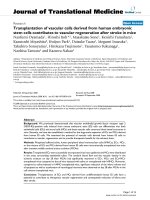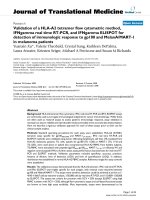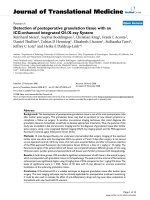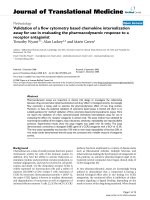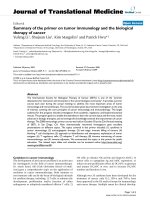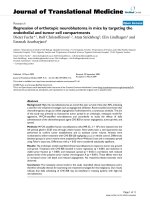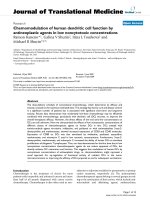báo cáo hóa học:" Discontinuation of standard first-line antiretroviral therapy in a cohort of 1434 Malawian children" ppt
Bạn đang xem bản rút gọn của tài liệu. Xem và tải ngay bản đầy đủ của tài liệu tại đây (215.11 KB, 4 trang )
SHOR T REPOR T Open Access
Discontinuation of standard first-line antiretroviral
therapy in a cohort of 1434 Malawian children
W Chris Buck
1*
, Mark M Kabue
2
, Peter N Kazembe
2
, Mark W Kline
3
Abstract
The standard first-line antiretroviral (ART) regimen in Malawi for both adults and children is a fixed-dose combina-
tion tablet containing stavudine (d4T), lamivudine (3TC) and nevirapine (NVP). This regimen has been shown to
yield satisfactory virologic and immunologic outcomes in children. Publis hed studies have described insights into
discontinuation of first-line regimen and toxicities of ART in adults, but similar studies in paediatric populations are
lacking.
A retrospective cohort study was undertaken to assess reasons for discontinuation of the standard first-line ART
regimen (d4T/3TC/NVP) in a paediatric population. In total, 1434 patients met eligibility criteria and were included.
The cohort had mean and median age at ART initiation of 4.7 years and 2.9 years, respectively (range: 0.1 months-
18.7 years). The gender distribution was 47% female and 53% male. Median follow-up time on ART was 1.8 years
(range: 2 weeks-3.9 years). A majority (96.2%) of patients were on the standard first-line ART regimen, while 3.8%
(54) were on a different regimen. Twenty-eight patients (2.0%) were on an alternative first-line regimen due to toxi-
cities, 22 patients (1.5%) were on a second-line regimen due to ART failure, and four patients (0.3%) were on a
non-standard regimen for other clinical reasons.
Of the 28 patients who experienced toxicities requiring ART regimen change, 60.7% (17) were caused by NVP,
39.3% (11) by d4T, and none by 3TC. The median time from first-line ART initiation to alternative first-line ART was
two months (range: 10 days-28.1 months); 60.7% of patients on alternative first-line ART were male. Average time
on ART until switch to second-line ART regimen was 16.3 months (SD: 9.3 months). The probability of failure after
one year on first-line regimen was 1.6% (95% CI: 0.9-2.6).
There was no compelling evidence in this cohort, representing approximately 10% of all children on ART in Malawi,
to support changing the standard paediatric first-line regimen based on early toxicities or failure. However, experi-
ence from the national adult cohort, longer term follow up of the paediatric cohort in this study, emerging data
on resistance after single-dose NVP containing mother to child transmission antiretroviral prophylaxis, and new
2009 World Health Organization ART recommendations may influence national policy change to a different first-
line regimen.
Findings
The standard first-line antiretroviral (ART) regimen in
Malawi for both adults and children is a fixed-dose
combination tablet containing stavudine (d4T), lamivu-
dine (3TC) and nevirapine (NVP). This regimen is
cheap and convenient , especially where there are limited
affordable alternatives for children in resource-limited
countries like Malawi. NVP is dosed once daily for the
first two weeks of ART using separate d4T/3TC and
NVP tablets, and then increase d to twice daily dosing
using d4T/3TC/NVP fixed-dose combination tablets if
well tolerated.
Children are dosed according to loca lly-developed
weight-b and dosing tables using fractions of adult Trio-
mune 30 tablets. This approach has been shown to
result in satisfactory virologic and immunologic benefit
to children [1]. However, there ar e concerns about NVP
drug levels in children on fractionated adult tablets [2].
Thereisalsoevidencethatsingle-doseNVP(sdNVP)-
containing mother to child transmission (MTCT) antire-
trov iral (ARV) prophylaxis regimens increase the risk of
resistance and failure of NVP-based ART regimens in
* Correspondence:
1
Baylor College of Medicine International Pediatric AIDS Initiative, Houston,
Texas, USA
Full list of author information is available at the end of the article
Buck et al. Journal of the International AIDS Society 2010, 13:31
/>© 2010 Buck et al; licensee BioMed Central Ltd. This is an Open Access article distributed under the terms of the Creative Commons
Attribution License ( which permits unrestricted use, dis tribution, and reproduction in
any medium, provided the origina l work is properly cited.
children [3]. During the time of t his study, all children
received split adult Triomune 30 tablets as the paedia-
tric formulation; Triomune Baby was introduced at a
national level in 2009, after our study period. In addi-
tion, there were no provisions for a protease inhibitor-
based first-line regimen for infants with sdNVP MTCT
ARV prophylaxis exposure in the national ART
guidelines.
The national ART programme offers additional ART
regimens when d4T/3TC/NVP is no longer a tolerable
or effective regimen. In the case of adverse drug reac-
tions or toxicities to the first-line regimen, alternative
first-line regimens are available, which replace d4T with
zidovudine (AZT), and NVP with efavirenz (EFZ). In
cases of ART failure, which can be diagnosed clinically,
immunologically or virologically depending on the set-
ting, second-line regimens are available. The adult
second-line regimen is AZT, 3TC, tenofovir and lopina-
vir/ritonavir, while the paediatric second-line regimen is
abacavir, didanosine and lopinavir/ritonavir.
The Malawi Ministry of Health is investigating a
pot ential change of the national standard first-line regi-
men, in part due to concerns about the high prevalence
of d4T-related toxicities, particularly peripheral neuro-
pathy in adults, in line w ith guidelines released World
Health Organization (WHO) in late 2009 on preferred
first-line ART regimens [4]. Published studies have
described insi ghts into discontinuation of first-line regi-
men and toxicities to ART in adults [5], but similar stu-
dies in paediatric populations are lacking [6,7].
An analysis of retrospectively collected cohort data
was undertaken to assess the reasons for discontinuation
of standard first-line ART in a cohort of children at the
Baylor College of Medicine-Abbott Fund Children’s
Clinical Centre of Excellence-Malawi as a step towards
assisting the Ministry of Health in making an informed
decision based on locally available data. Our paediatric
HIV care programme operates from the capital city,
Lilongwe, and has enrolled more than 4500 infants and
children since its inception in 2004. As of July 2009,
there was an active caseload of 2330 HIV-infected and
exposed patients, 1444 of whom were on ART. By the
end of 2008, our patient population represented
approximately 10% of all children ever initiated on AR T
in Malawi [8].
We investigated the discontinuation of standard first-
line ART as our primary outcome. Toxicities were
defined as adverse events reported after ART initiation,
which were confirmed clinically or with laboratory tests
when available. ART failure was identified clinically,
immunologically and virologically using national ART
and WHO guidelines.
Eligibility criteria for the study were patients aged 19
years or younger, with at least two clinic visits, who
were ART-naïve at the time of standard first-line initia-
tion (excluding MTCT ARV prophylaxis exposure), and
who had enrolled between November 2004 and October
2008, either at our clinic or at its predecessor clinic at
Kamuzu Central Hospital in Lilongwe. All patients had
records in our electronic medical record (EMR) which
were de-identified and subsequently reviewed. Patients
on an ART regimen other than the standard first-line
regimen were identified through the EMR and con-
fir med by cross checking with our paper-based national
ART registers. It is not possible to reliably query our
EMR for patients who had ART toxicities or first-line
failure that did not result in an ART regimen change.
For this reason, we used discontinuation of the first-line
regimen as a proxy for toxicity and failure. Data were
analyzed using STATA version 9 (STATA Corporation,
College Station, Texas, USA).
A total of 1434 patients met eli gibility criteria and
were included in this review. Fewer than 15 patients had
stopped ART for poor adherence or social concerns at
the time of the analysis an d were not included in thi s
review as they were expected to resume the standard
first-line regimen at the time of re-initiation. The cohort
had mean and median ages at ART initiation of 4.7
years and 2.9 years, respectively, with a range of 0.1
months to 18.7 years. The gender distribution was 4 7%
female and 53% male. The median follow-up time on
ART was 1.8 years with a range of two weeks to 3.9
years.
A majority of patients (96.2%) were on the standard
first-line ART regimen, while 3.8% (54) were on a differ-
ent regimen: 28 patients (2.0%) were on an alternative
first-line regimen due to toxicities, 22 patients (1.5%)
were on a second-line regimen due to failure, and four
patients (0.3%) were on a non-standard regimen for
other clinical reasons. Of the 28 patients with toxicities
requiring ART regimen change, 60.7% (17) were relat ed
to NVP, 39.3% (11) were related to d4T, and none were
related to 3TC, as shown in Table 1.
The median time to substitution of alternative first-
line ART was two months, with a range of 10 days
to 28.1 months. Of the patients on alternative first-line
ART, 60.7% w ere male. Average time on ART until
switch to second-line ART regimen was 16.3 months
(SD: 9.3 months). The probability of failure after
one year on the first-line regimen was 1.6% (95%
CI: 0.9-2.6).
This retrospective cohort review shows that the Mala-
wian standard firs t-line ART regimen of d4T/3TC/NVP
fixed-dose combination resul ted in limited early t oxici-
ties requiring ART regimen c hange in this paediatric
population. It also shows that early first-line ART failure
requiring switch to second-line ART was not commonly
diagnosed in our cohort.
Buck et al. Journal of the International AIDS Society 2010, 13:31
/>Page 2 of 4
There are limitations of this retrospective review that
should be mentioned. First, due to the study design,
there are certainly patients in this large cohort with
toxicities that were not captured, either because the
patients’ adverse reactions were not severe enough to
warrant a regimen change or because they were never
diagnosed. This is of particular concern with respect to
lipodystrophy. In addition, as per national guidelines,
patients did not get routine laboratory monitoring for
ART toxicities, such as liver function tests, pancreatic
enzymes or other chemistry investigations. This
approach of no routine laboratory monitoring has been
validated as cost effective and safe in African settings,
but likely results in under-diagnosis of sub-clinical
laboratory toxicities [9].
Another limitation of our study design is that it only
captured patients who had been switched to second-line
ART for confirmed failure. Our patients do get biannual
CD4 testing, but routine viral load testing is not done at
our clinic, or anywhere in the Malawi national ART
programme. As a result, first-line failure is almost cer-
tainly under-represented here as patients have to present
with later-onset c linical or immunologic failure before
viral load tests are ordered.
A final limitation is that the median time on ART was
relatively short at only 1.8 years, as the national ART
programme only began including ART for children in
the public health facilities in 2004. Many metabolic
complications from longer term d4T treatment, includ-
ing peripheral neuropathy, lactic acidosis and lipodystro-
phy, might not have presented within this limited
timeframe. A similar analysis will need to be repeated in
the future to evaluate metabolic complications a fter
patients have been on ART for longer periods.
In conclusion, there was no compelling evidence in
this cohort, representing approximately 10% of all chil-
dren on ART in Malawi, to support changing the stan-
dard Malawian first-line regimen of d4T/3TC/NVP
based on early toxicities or failure. However, experience
from the adult cohort, longer term follow up of the pae-
diatric cohort in this study, emerging data on NVP
resistance after sdNVP-containing MTCT ARV prophy-
laxis, and new 2009 WHO ART recommendation s may
influence national policy change to a different first-line
regimen.
Acknowledgements
The authors would like to acknowledge Gordon E Schutze, MD, who gave
valuable editorial input on the manuscript. We would also like to thank the
clinical team at the Baylor College of Medicine-Abbott Fund Children’s
Clinical Centre of Excellence-Malawi, who provide care to this patient group,
as well as the monitoring and evaluation team that maintains the clinical
databases used in this study. MMK’s involvement was supported in part by
Table 1 Reasons for discontinuation of standard first-line ART regimen
Reason for discontinuation of
standard first-line ART (d4T/3TC/NVP)
a
Number of patients (male/female) Proportion of
total cohort of 1434 patients (%)
Toxicity 28 (17/11) 1.95%
• Nevirapine - rash (unknown WHO grade) 1 (0/1) 0.07%
• Nevirapine - rash (WHO grade II) 5 (3/2) 0.35%
• Nevirapine - rash (WHO grade III) 4 (2/2) 0.28%
• Nevirapine - Stevens-Johnson syndrome (WHO grade IV)
b
5 (4/1) 0.35%
• Nevirapine - hepatitis (WHO grade IV)
c
2 (2/0) 0.14%
• Nevirapine - total 17 (11/6) 1.19%
• Stavudine - pancreatitis (WHO grade III) 3 (2/1) 0.21%
• Stavudine - pancreatitis (WHO grade IV) 2 (1/1) 0.14%
• Stavudine - lactic acidosis (unknown WHO grade) 1 (1/0) 0.07%
• Stavudine - lactic acidosis (WHO grade III) 3(1/2) 0.21%
• Stavudine - peripheral neuropathy (unknown WHO grade) 1 (0/1) 0.07%
• Stavudine toxicity - peripheral neuropathy (WHO grade III) 1 (1/0) 0.07%
• Stavudine - total 11 (6/5) 0.76%
First-line failure
d
22 (16/6) 1.53%
Other
e
4 (3/1) 0.28%
a
Toxicity grading per 2006 WHO guidelines (I-mild, II-moderate, III-severe, IV-severe, potentially life-threatening).
b
One patient died from drug-induced SJS.
c
One patient had a negative Hepatitis B surface antigen test documented. Serologies for other viral hepatitides are not available in Malawi. Neither patient was
on concurrent TB treatment.
d
All patients in our cohort had confirmed virologic failure on first-line ART.
e
Four Kaposi’s sarcoma patients had been placed on a protease inhibitor-based regimen for possible antiangiogenic effects.
Buck et al. Journal of the International AIDS Society 2010, 13:31
/>Page 3 of 4
grant D43 TW01036 from the Fogarty International Center of the National
Institutes of Health.
Author details
1
Baylor College of Medicine International Pediatric AIDS Initiative, Houston,
Texas, USA.
2
Baylor College of Medicine-Abbott Fund Children’s Clinical
Centre of Excellence - Malawi.
3
Department of Pediatrics, Baylor College of
Medicine, and Texas Children’s Hospital, Houston, Texas, USA.
Authors’ contributions
WCB participated in the design of the study, data collection, and writing of
the manuscript. MMK participated in the design of the study, data collection,
data analysis, and writing of the manuscript. PNK participated in the design
of the study, and reviewing the manuscript. MWK participated in revising
the manuscript, and giving final approval of the version to be published.
All authors have read and approved the final manuscript.
Competing interests
The authors declare that they have no competing interests.
Received: 21 January 2010 Accepted: 6 August 2010
Published: 6 August 2010
References
1. Chokephaibulkit K, Plipat N, Cressey TR, Frederix K, Phongsamart W,
Capparelli E, Kolladarungkri T, Vanprapar N: Pharmacokinetics of
nevirapine in HIV-infected children receiving an adult fixed-dose
combination of stavudine, lamivudine and nevirapine. AIDS 2005,
19:1495-1499.
2. Ellis J, L’homme R, Ewings F, Mulenga V, Bell F, Chileshe R, Molyneux E,
Abernathy J, van Oosterhout J, Chintu C, Walker S, Gibb D, Burger D:
Nevirapine concentrations in HIV-infected children treated with divided
fixed-dose combination antiretroviral tablets in Malawi and Zambia.
Antiviral Therapy 2007, 12:253-260.
3. Palumbo P, Violari A, Lindsey J, Hughes M, Jean-Philippe P, Mofenson L,
Purdue L, Eshleman S: Nevirapine vs. lopinavir-ritonavir-based
antiretroviral therapy (ART) in single dose nevirapine (sdNVP)-exposed
HIV infected infants: preliminary results from the IMPAACT P1060 trial.
HIV Pediatrics , Cape Town, abstract LBPEB12, July 2009.
4. World Health Organization: Rapid advice: antiretroviral therapy for HIV
infection in adults and adolescents. Electronic version 2009 [.
int/hiv/pub/arv/rapid_advice_art.pdf].
5. d’Arminio Monforte A, Lepri AC, Rezza G, Pezzotti P, Antinori A, Phillips AN,
Angarano G, Colangeli V, De Luca A, Ippolito G, Caggese L, Soscia F,
Filice G, Gritti F, Narciso P, Tirelli U, Moroni M: Insights into the reasons for
discontinuation of the first highly active antiretroviral therapy (HAART)
regimen in a cohort of antiretroviral naïve patients. I.CO.N.A. Study
Group. Italian Cohort of Antiretroviral-Naïve Patients. AIDS 2000, 14(Suppl
5):499-507.
6. Gil AC, Lorenzetti R, Mendes GB, Morcillo AM, Toro AA, Silva MT, Vilela MM:
Hepatotoxicity in HIV-infected children and adolescents on antiretroviral
therapy. Sao Paulo Med J 2007, 125:205-209.
7. McComsey G, Leonard E: Metabolic complications of HIV therapy in
children. AIDS 2004, 18:1753-1768.
8. Malawi Ministry of Health, HIV Unit: Treatment of AIDS. A Five-Year Plan for
the Provision of Antiretroviral Therapy and Good Management of HIV-related
Diseases to HIV-infected Patients in Malawi 2006-2010 [http://www.
hivunitmohmw.org/uploads/Main/ARV-ScaleUpPlan_2006-2010.pdf].
9. Dart Trial Team: Routine versus clinically driven laboratory monitoring of
HIV antiretroviral therapy in Africa (DART): a randomised non-inferiority
trial. Lancet 2010, 375:123-131.
doi:10.1186/1758-2652-13-31
Cite this article as: Buck et al.: Discontinuation of standard first-line
antiretroviral therapy in a cohort of 1434 Malawian children. Journal of
the International AIDS Society 2010 13:31.
Submit your next manuscript to BioMed Central
and take full advantage of:
• Convenient online submission
• Thorough peer review
• No space constraints or color figure charges
• Immediate publication on acceptance
• Inclusion in PubMed, CAS, Scopus and Google Scholar
• Research which is freely available for redistribution
Submit your manuscript at
www.biomedcentral.com/submit
Buck et al. Journal of the International AIDS Society 2010, 13:31
/>Page 4 of 4
